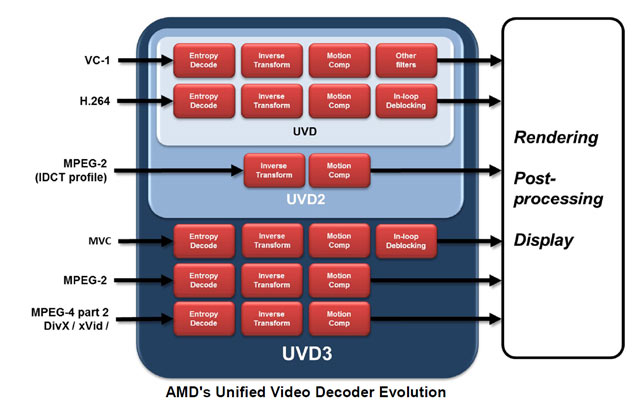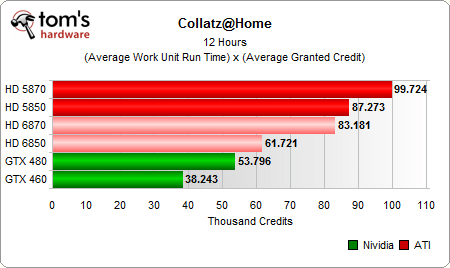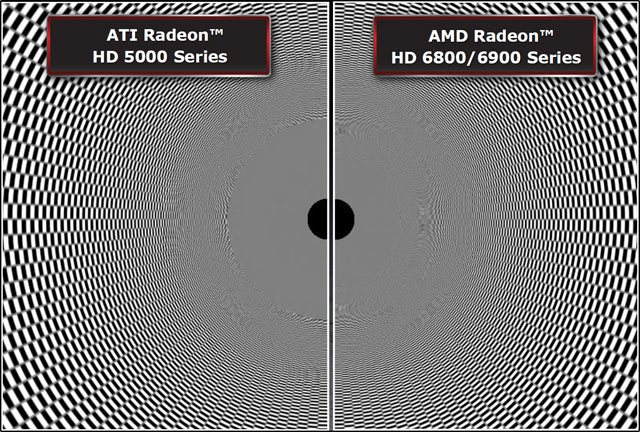AMD Radeon HD 6870 And 6850: Is Barts A Step Forward?
Eyefinity, UVD3, And AMD APP Compute
Eyefinity Enhancements
For the most part, Eyefinity as a feature is largely unchanged in the shift to AMD's Radeon HD 6800-series. That makes sense. After all, it's still uncontested by Nvidia, which can only enable two simultaneous display outputs, even on its highest-end boards.
DisplayPort 1.2 is one capability that AMD did add, enhancing bandwidth over the interface, integrating support for high-bit rate audio alongside video, and defining compatibility with the next generation of 120 Hz 3D monitors. Moreover, DisplayPort 1.2 is able to drive multiple displays from each output. That's right. DisplayPort displays can now be daisy-chained. That is to say a single DisplayPort output can use a Multi-Stream Transport (MST) hub to split off into multiple DP/VGA/DVI/HDMI displays of your choosing. Special Eyefinity edition cards are no longer necessary for six-monitor use.
Note that the reference Radeon HD 6800-series outputs include two DVI outputs, an HDMI output, and two mini-DisplayPort outputs. While the number of supported displays has increased, there has been a trade-off in that only one DVI output is dual-link. The DVI output below the exhaust port is a single-link limited to 1920x1080 resolution. In return, you're able to directly attach four monitors today: two DisplayPort and two using a combination of DVI and HDMI.
There are some interesting Eyefinity features coming down the pipeline in the future, including a 5x1 portrait display group that would fill the player’s periphery. The possibility of combining Eyefinity display groups and HD3D is also something AMD staff hinted at.
Eyefinity remains one of AMD's most interesting value-adds for gamers and productivity-oriented enthusiasts who use more than two displays. Nvidia requires an SLI configuration to enable its Surround mode. The fact that we can use triple-display configurations (now quad-display) from an AMD card is outright compelling.
UVD3
Get Tom's Hardware's best news and in-depth reviews, straight to your inbox.
The Radeon HD 6000-series cards include AMD’s third-generation Unified Video Decoder (UVD) hardware. Building on the UVD1 and UVD2 feature set, the new version adds acceleration for MPEG-2 bitstream, MPEG-4 Part 2 Advanced Simple Profile , and the Multi-View Codec (MVC) decode to the mix. Remember that the MVC codec is used for Blu-ray 3D playback, an important feature for the Radeon HD 6000s. Simply, UVD3 accelerates, in hardware, additional steps in the decode pipeline that weren't being sped-up before.
How will AMD's UVD3 measure up to the fixed-function decode hardware built into Intel's upcoming Sandy Bridge-based CPUs? It's still early to tell, but we have it on good authority that Intel put a lot of effort into that particular block of logic, and that both AMD and Nvidia are going to be way behind in this regard. This would coincide with what we experienced first-hand from Intel at IDF 2010. Naturally, that'll be a shock to many people--ATI, back when it was ATI, was routinely known for its uncontested video playback quality and performance.
AMD APP Technology
ATI Stream is dead. We're guessing that name got dragged around for too long while general purpose GPU-oriented development languished. It was time for something new. Meet AMD Accelerated Parralel Processing (APP).
Yes, the brand was renamed to a more descriptive term. But aside from that, there isn’t much to address in today's story. There are certainly some interesting applications in the pipeline, and we’re hoping to get our hands on some nifty OpenCL- and DirectCompute-based applications to test in the future. Perhaps the most relevant demonstration of APP we saw at the launch was use of the Bullet physics library to fracture and destroy geometry in real-time. Then again, we were hearing about Bullet a year ago. Before that, Stream was the topic of discussion at the Radeon HD 4870 launch.
A muscle car on slicks in the snow could have found traction by now, and yet the tenets of Stream continue to prove amorphous at best. This is something that AMD is going to need/want to figure out soon. We're staring down the barrel of its Fusion initiative, so the timing couldn't be any better for apps to start materializing with more force. We're waiting.
To compare raw compute ability with existing products we do have the results of a Collatz@Home distributed computing application test to examine:
With the Radeon HD 6800-series cards sharing essentially the same architecture as the 5000s, the results aren’t exactly surprising. As expected, the combination of fewer stream cores combined with a higher clock rate brings the Radeon HD 6870 performance very close to the Radeon HD 5850.
Other Improvements
AMD is proud of its angle-independent anisotropic filtering method, and the Radeon HD 6000-series takes it a step closer to crystal-clear by smoothing the transition between filter levels. Eric Demers clarified that, despite some concerns about the Radeon HD 5000-series’ filtering, the new 6800s use the exact same angle-independent linear LOD as its predecessor, and the problem was limited to uneven shifting of kernels within a MIP level. This has been improved with better transitions in the same MIP layer.
Current page: Eyefinity, UVD3, And AMD APP Compute
Prev Page Morphological Anti-Aliasing Next Page AMD's Radeon HD 6870 1 GBDon Woligroski was a former senior hardware editor for Tom's Hardware. He has covered a wide range of PC hardware topics, including CPUs, GPUs, system building, and emerging technologies.
-
SteelCity1981 Yeah I agree. I don't get AMD's marketing on the 6000 series. One would think that the 6870 would obv performan better then the 5870 at first glance but instead it yelds less performance then the 5870. That just doesn't make any sense from a consumor standpoint.Reply -
TheRockMonsi I like where AMD is going with the 6000 series, not so much with naming, but pretty much everything else about it. Can't wait for the 6900's, those are going to be beasts!!!!!Reply -
Poisoner I think AMD did a great job with these cards. Its just sick at what performance you can get for 200 bucks.Reply -
duk3 Nice benchmark suite!Reply
I am looking forward to the 6900 series and 22nm gpus later on for some real performance improvements. -
takeapieandrun Not exactly powerhouses, but I do believe they will be great for market competition.Reply -
forces nice but... where is Crysis!!!? they can play Crysis i know but how well can they play it? everyone has Crysis and have played Crysis and will play it... :(, its a nice game to compare perfomance...Reply




